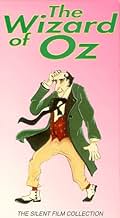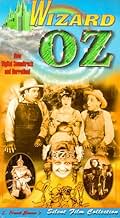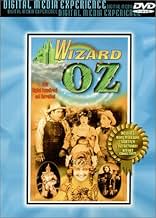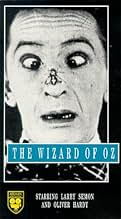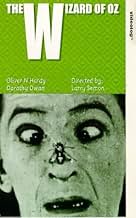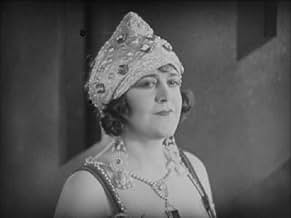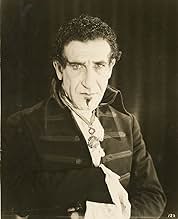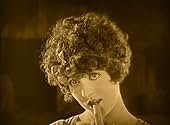CALIFICACIÓN DE IMDb
4.9/10
1.9 k
TU CALIFICACIÓN
Dorothy, heredera del trono de Oz, debe recuperárselo del malvado primer ministro Kruel con la ayuda de tres peones.Dorothy, heredera del trono de Oz, debe recuperárselo del malvado primer ministro Kruel con la ayuda de tres peones.Dorothy, heredera del trono de Oz, debe recuperárselo del malvado primer ministro Kruel con la ayuda de tres peones.
- Dirección
- Guionistas
- Elenco
- Premios
- 1 premio ganado en total
Oliver Hardy
- Woodsman
- (as Oliver N. Hardy)
- …
Curtis 'Snowball' McHenry
- Snowball
- (as G. Howe Black)
- …
Rosalind Byrne
- Herald Trumpeter
- (sin créditos)
Chester Conklin
- Undetermined Role
- (sin confirmar)
- (sin créditos)
Wanda Hawley
- Undetermined Role
- (sin confirmar)
- (sin créditos)
Jean Johnston
- Little Girl in open & close
- (sin créditos)
Opiniones destacadas
I approached this film with great interest. Being a fan of Oz in general and silent film in particular, this seemed like a sure fit. Well, it's hard to put all prejudices aside, having (like most people) been bombarded with various adaptations of L. Frank Baum's book that one naturally has preconceptions.
Now, I won't bother to comment on the liberties taken in this film, the 1939 film bears, in all truth, barely a passing resemblance to Baum's dark and bizarre novel. The problem is, the changes made for this film just don't work. It's really just a standard silent slapstick film, but not a very funny one.
It's hard to sit through 90 minutes of lame jokes and vulgar stereotypes. But, as a historical curiosity, the film merits a once-over. I cannot, however, endorse the release pictured on the IMDb page, with it's "Digital Soundtrack" and "Narration." The music is inappropriate and the narration is silly...I mean, I CAN read for myself thank you! It was like sitting in the theatre with some rude patron talking to the screen! I expect this was added for children watching the films, but I really don't think many young children today would sit through this, sadly.
See it at least once, but don't expect too much from it.
Now, I won't bother to comment on the liberties taken in this film, the 1939 film bears, in all truth, barely a passing resemblance to Baum's dark and bizarre novel. The problem is, the changes made for this film just don't work. It's really just a standard silent slapstick film, but not a very funny one.
It's hard to sit through 90 minutes of lame jokes and vulgar stereotypes. But, as a historical curiosity, the film merits a once-over. I cannot, however, endorse the release pictured on the IMDb page, with it's "Digital Soundtrack" and "Narration." The music is inappropriate and the narration is silly...I mean, I CAN read for myself thank you! It was like sitting in the theatre with some rude patron talking to the screen! I expect this was added for children watching the films, but I really don't think many young children today would sit through this, sadly.
See it at least once, but don't expect too much from it.
This WIZARD OF OZ is merely a frantic slapstick showcase for LARRY SEMON, apparently a silent comedian who is unknown to today's audiences and who died at a young age (39). He had a hand in the production and even designed his own Scarecrow costume, but the film is a curio that starts with a toymaker (again, LARRY SEMON) who tells a little girl the story of Dorothy (DOROTHY DWAN) from Kansas who, it turns out, is heir to be ruler of The Land of Oz.
But the story he tells has nothing whatsoever to do with L. Frank Baum's story as we know it from the '39 version starring Judy Garland. And this Dorothy is a grown-up young lady of 18 who bats her eyelashes and puts a finger to her lips in a coy manner as though signifying youthful uncertainty.
The only connection to the Oz story Baum gave us is the tornado, the effects for which are very good for 1925, and the combination of the Tin Man, The Scarecrow and The Cowardly Lion. OLIVER HARDY is the Tin Man (before his screen partnership with Stan Laurel), SPENCER BELL, a black man, is the Cowardly Lion and LARRY SEMON hogs the whole show as The Scarecrow. The best I can say for Lemon is that his costume and make-up for the role is laudable.
But the fragments of story used here are all over the map, the key to everything being the chance to have all of the performers involved in slapstick stunts. Only MARY CARR as Aunt Em is spared this indignity.
There are a few well staged moments that one can appreciate but all in all it's a bit too much for any adult to watch and I have no idea what children thought of this bizarre exercise in slapstick comedy.
But the story he tells has nothing whatsoever to do with L. Frank Baum's story as we know it from the '39 version starring Judy Garland. And this Dorothy is a grown-up young lady of 18 who bats her eyelashes and puts a finger to her lips in a coy manner as though signifying youthful uncertainty.
The only connection to the Oz story Baum gave us is the tornado, the effects for which are very good for 1925, and the combination of the Tin Man, The Scarecrow and The Cowardly Lion. OLIVER HARDY is the Tin Man (before his screen partnership with Stan Laurel), SPENCER BELL, a black man, is the Cowardly Lion and LARRY SEMON hogs the whole show as The Scarecrow. The best I can say for Lemon is that his costume and make-up for the role is laudable.
But the fragments of story used here are all over the map, the key to everything being the chance to have all of the performers involved in slapstick stunts. Only MARY CARR as Aunt Em is spared this indignity.
There are a few well staged moments that one can appreciate but all in all it's a bit too much for any adult to watch and I have no idea what children thought of this bizarre exercise in slapstick comedy.
After its 1902 tryout in Chicago, the stage play with songs by Paul Tietjens and Baum opened on Broadway in January 1903, running 293 performances before hitting the road, and returning to Broadway for four or five months in 1904. It then toured until 1911, when Baum permitted a host of amateur companies all over America to stage the play. In many areas, it became an annual event.
As Mordaunt Hall noted in his rave review in The New York Times, this version is not based on Baum's 1900 novel but on his 1902 stage musical. Many of the strange changes and eliminations in both the story and the characters were made by Baum himself. In fact, aside from the obvious enlargement of Larry Semon's role with the addition of a goodly number of comic routines, this movie is a pretty faithful transcription of the play.
True, some of the best jokes (the business with packing cases, for example), are worked to exhaustion. The main problem I find, however, is not that the stage play and movie have been converted into slapstick, but that the movie without the songs is often rather dull, despite the best efforts of Oliver Hardy and Charlie Murray.
As Mordaunt Hall noted in his rave review in The New York Times, this version is not based on Baum's 1900 novel but on his 1902 stage musical. Many of the strange changes and eliminations in both the story and the characters were made by Baum himself. In fact, aside from the obvious enlargement of Larry Semon's role with the addition of a goodly number of comic routines, this movie is a pretty faithful transcription of the play.
True, some of the best jokes (the business with packing cases, for example), are worked to exhaustion. The main problem I find, however, is not that the stage play and movie have been converted into slapstick, but that the movie without the songs is often rather dull, despite the best efforts of Oliver Hardy and Charlie Murray.
While disappointing (to say the least), there are at least two interesting things about this version. One is to see someone who is not Buster Keaton or Charlie Chaplin (but is in fact Larry Semon, one of their contemporaries) trying to imitate them in what was clearly designed to be a star vehicle for him. It makes the work of the other two men seem that much more remarkable when you watch some of their competition.
The most interesting thing about this production, though, is perhaps the fact that the MGM version was made only 14 short years later. The world moves very fast sometimes.
The most interesting thing about this production, though, is perhaps the fact that the MGM version was made only 14 short years later. The world moves very fast sometimes.
Even in it's day, I think that this movie would have been looked on as rather average. It just isn't a patch on the classic 1939 version. The scarecrow, the tin man and the cowardly lion are not characters, but rather disguises that three of the characters "put on". And there is no witch at all. [Margaret Hamilton, we miss you.] Although the plot is good, the way it's done would confuse younger children, and it somehow just doesn't hold up. It is interesting to see, only for its historic aspect.
¿Sabías que…?
- TriviaMany theatres that booked the film never received it because its production caused Chadwick Pictures to go bankrupt, and distribution ceased long before it was intended to.
- ErroresThe plane that brings Kruel's emissaries from Oz to Kansas is a triplane in midair but a biplane when it lands.
- Citas
Prime Minister Kruel: Do your stuff, Wizzy!
- Versiones alternativas2005 DVD release on Warner Brothers (as a bonus feature with the 1939 version) alternates between sepia tone-colored images and blue-tinted images.
- ConexionesFeatured in Wiz on Down the Road (1978)
Selecciones populares
Inicia sesión para calificar y agrega a la lista de videos para obtener recomendaciones personalizadas
Detalles
- Fecha de lanzamiento
- País de origen
- Idioma
- También se conoce como
- Tomasín en el reino de Oz
- Productora
- Ver más créditos de la compañía en IMDbPro
- Tiempo de ejecución1 hora 35 minutos
- Mezcla de sonido
- Relación de aspecto
- 1.33 : 1
Contribuir a esta página
Sugiere una edición o agrega el contenido que falta

Principales brechas de datos
By what name was The Wizard of Oz (1925) officially released in India in English?
Responda

